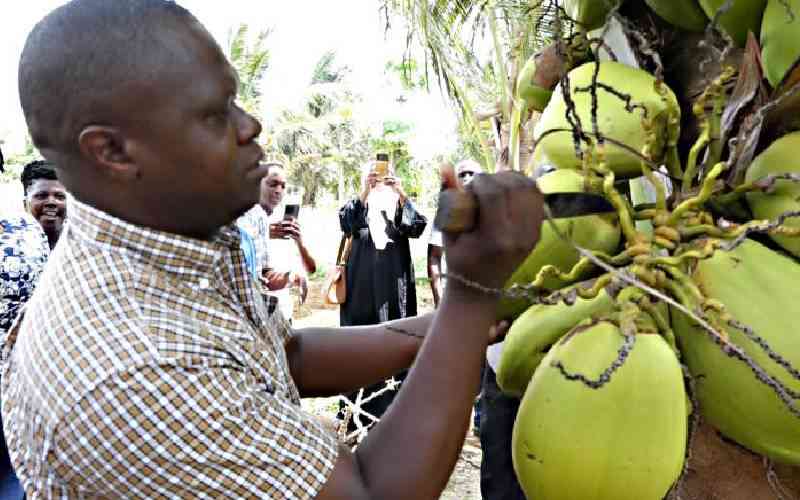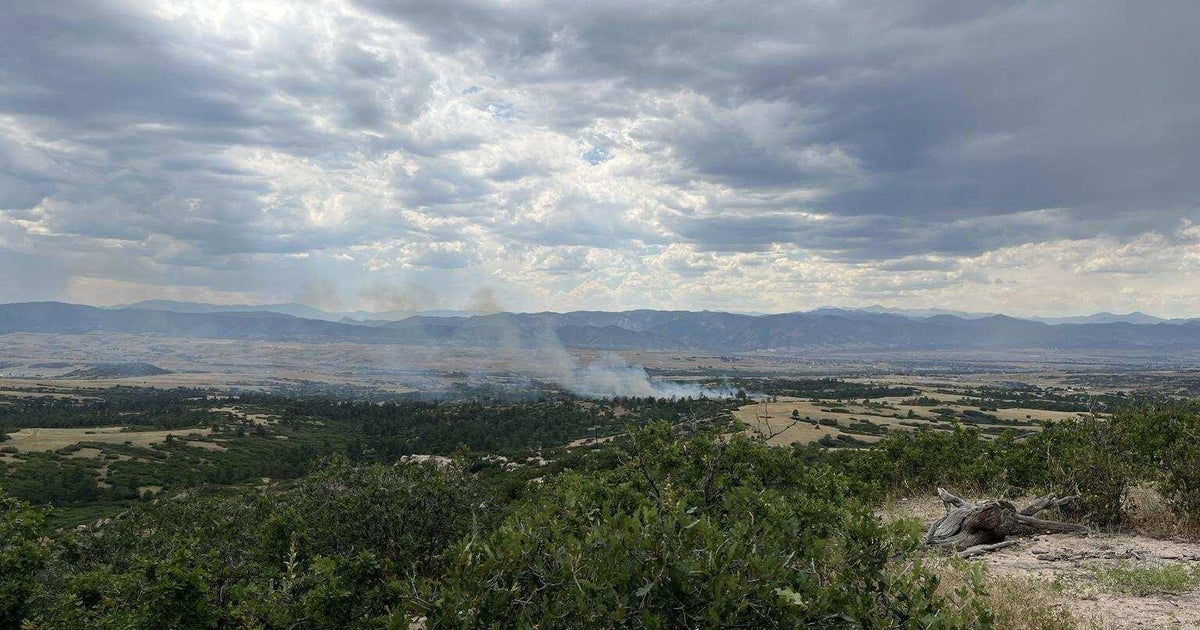Kilifi farmers turn to hybrid coconut variety to boost earnings

The coconut industry at the Coast is on its knees thanks to ageing East African Tall (EAT) varieties, pests and diseases, poor market linkages, and vagaries of climate change.
Johnstone Mbigo, a 73-year-old farmer in Junju Ward, Kilifi County, has witnessed this firsthand. “In the 1990s, I earned up to Sh80,000 per season. Now, I make less than Sh20,000 from three seasons combined,” he laments.
With only 50 trees remaining on his two-acre plot, he faces the reality of losing his livelihood. “My grandfather had tens of acres. Today, after land subdivision and family inheritance, I’m left with almost nothing,” he added.
Standing in his nearly barren palm farm, 73-year-old Johnstone Mbigo also gazes somberly at a freshly cut coconut stump, a silent testament to a once-thriving plantation.
Nearby, his son gathers dried palm leaves to weave makuti brooms, a modest reminder of the family’s former prosperity. With eight children relying solely on coconut farming, Mbigo now faces an uncertain future.
“For decades, farmers relied on the EAT variety, but its slow maturity and reduced productivity have discouraged many. This is threatening the industry’s survival,” explains Kazungu Ngowa, Kilifi County Agribusiness Officer.
The story is echoed across coastal counties—Mombasa, Kilifi, Kwale, Lamu, Tana River, and Taita-Taveta—where over 100,000 smallholder farmers depend on coconut farming.
Coconut is not just a source of income but a cultural staple, providing nuts, madafu (tender coconut), copra, makuti (roofing), and brooms.
According to the 2024 Agricultural Productivity Report by the Ministry of Agriculture and Livestock Development, more than 2.6 million of Kenya’s 10 million coconut trees are over 60 years old, producing as few as 28 nuts per tree each year.
The crisis has been deepened by deforestation, rapid urbanisation, and unsustainable farming practices.
In 2019, Kilifi County, in collaboration with Kenya Agricultural and Livestock Research Organization (Kalro) and Kenya Plant Health Inspectorate Service (Kephis), marked a significant milestone by introducing the Sampoorna hybrid, a high-yielding Dwarf Tall variety from India.
The hybrid matures in just 2.5 to 3 years, compared to seven years for the EAT, and produces up to 300 nuts per year, triple the traditional yield.
“This variety also yields more coconut water and copra, with an oil content of 68 percent, slightly higher than the traditional type. Its shorter height, about 12 to 15 meters, makes harvesting safer and easier,” said Ngowa.
Through the Kenya Marine Fisheries and Socio-Economic Development (KEMFSED) project, Kilifi County is training farmers and offering grants to establish community seedling nurseries.
Stay informed. Subscribe to our newsletter
Mbigo has since founded the Junju Chodari Coconut Farmers Self-Help Group, which now has 30 members and runs a nursery of 10,000 seedlings.
“We realised reviving the coconut sector starts with quality seedlings,” says Mbigo. “We’re training others and expanding local access to ensure sustainability.”
The hybrid seedlings fetch between Sh250 and Sh500 each, turning community nurseries into a profitable venture for farmer groups.
For Mkazaa Yuwi, a member of Mbigo’s group in Kilifi, the change has been transformative. “I almost gave up,” she says. “But joining the farmers’ group revived my passion. The hybrid grows faster, yields more, and demand keeps rising. Here at the Coast, coconut is everything, and most of our meals are prepared with coconut milk. That alone gives me a reliable market.”
Growing interest from Tanzania is also reshaping dynamics. “Brokers are buying entire farms before harvest,” says Ngowa. “That shows how valuable these trees are again.”
Currently, a mature coconut fetches Sh30 to Sh50 at the farm gate but can go for up to Sh100 in the market. Even small-scale farms are now lucrative, thanks to the new variety.
But challenges remain. Drought is still a major threat, especially to the hybrid seedlings, which need up to 40 litres of water daily in dry seasons. Shrinking land sizes from subdivision reduce economies of scale. “Most of us have less than five acres now,” Mbigo says. “We inherited large farms, but times have changed.”
Pest infestations, particularly the rhinoceros beetle, require active management and farmer education. Meanwhile, value addition is still lacking.
“We sell raw nuts instead of processed coconut milk, virgin oil, or soap; that’s where the real money is,” notes Yuwi.
You may also like...
Diddy's Legal Troubles & Racketeering Trial

Music mogul Sean 'Diddy' Combs was acquitted of sex trafficking and racketeering charges but convicted on transportation...
Thomas Partey Faces Rape & Sexual Assault Charges

Former Arsenal midfielder Thomas Partey has been formally charged with multiple counts of rape and sexual assault by UK ...
Nigeria Universities Changes Admission Policies

JAMB has clarified its admission policies, rectifying a student's status, reiterating the necessity of its Central Admis...
Ghana's Economic Reforms & Gold Sector Initiatives

Ghana is undertaking a comprehensive economic overhaul with President John Dramani Mahama's 24-Hour Economy and Accelera...
WAFCON 2024 African Women's Football Tournament

The 2024 Women's Africa Cup of Nations opened with thrilling matches, seeing Nigeria's Super Falcons secure a dominant 3...
Emergence & Dynamics of Nigeria's ADC Coalition

A new opposition coalition, led by the African Democratic Congress (ADC), is emerging to challenge President Bola Ahmed ...
Demise of Olubadan of Ibadanland
Oba Owolabi Olakulehin, the 43rd Olubadan of Ibadanland, has died at 90, concluding a life of distinguished service in t...
Death of Nigerian Goalkeeping Legend Peter Rufai

Nigerian football mourns the death of legendary Super Eagles goalkeeper Peter Rufai, who passed away at 61. Known as 'Do...





